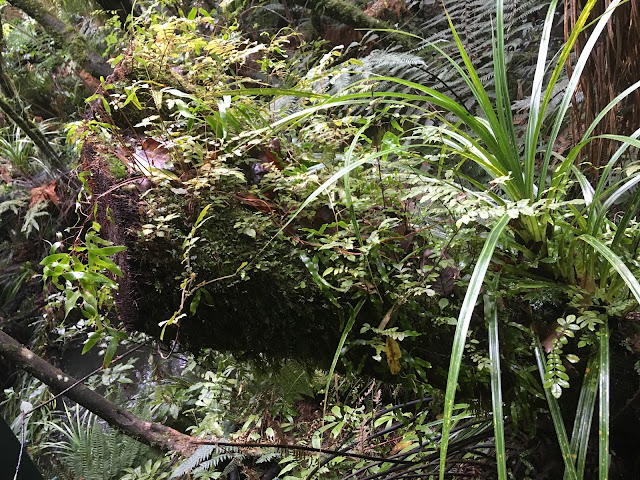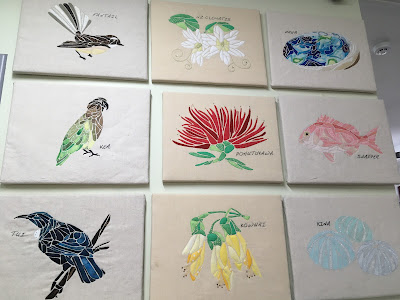 |
| An abundance of life from a dead tree! |
Another week gone, how can it be?! We enjoyed our Sr. Family Home Evening, District Council with the awesome Elders!, some renovating with friends, Ed had a doctor appointment south of Auckland, Maori class, a visit to a Marae, choir practice, A FHE with a great family...
Our monthly Senior missionary activity! I'm not sure if all missionaries act silly or just the Senior ones!

We spent some time assisting President Lisiati do some re-hab work on a member's home in Donnellys Crossing. The building/shed was almost 100 years old and was leaning over.
It is being converted into a 1 bedroom home, and is only about 400 square feet in size. Lisa and I felt like "old pros" when it came to putting the mud and tape on the sheet rock!
Lisa and I were invited to attend a day of learning at a Marae in Tinopai. The Marae is a sacred building used by the Maori for weddings, funerals, and learning activities. Most of the attendees arrived on Friday night, where they attended the Powhiri (greeting). I've included a detailed explanation of what happens at the Powhiri below. We arrived on Saturday morning, and were met by Joseph, one of our Maori class teachers. Since we were the only visitors arriving on Saturday, he personally walked us through and explained the sacredness of the Marae and what would be taking place...and then proceeded to do a Powhiri just for us. I sat across from the group of Maori, with Lisa sitting behind me
Several men spoke in Maori and then they were supported by their group singing a Maori song. It was then my turn to stand and speak. I basically bore my testimony of the Plan of Salvation and our purpose on earth and thanked the group for inviting us to come. Joseph then looked at me and asked if we had a song to sing to support my words. I looked at Lisa... and she looked at me and we knew we could not sing a Maori song ....so the two of us sang "I am a Child of God" It was a wonderful experience to feel the spirit as we participated in this sacred Powhiri with the Maori people.
Several men spoke in Maori and then they were supported by their group singing a Maori song. It was then my turn to stand and speak. I basically bore my testimony of the Plan of Salvation and our purpose on earth and thanked the group for inviting us to come. Joseph then looked at me and asked if we had a song to sing to support my words. I looked at Lisa... and she looked at me and we knew we could not sing a Maori song ....so the two of us sang "I am a Child of God" It was a wonderful experience to feel the spirit as we participated in this sacred Powhiri with the Maori people.
Waharoa – Gate way to the marae
Manuhiri – Visitors
Tangatawhenua – People of the land
Karanga – Call
Mahau – Veranda of the Marae
Kaikaranga – Woman who call to the people
Whaikorero – Formal Speech
Kaikorero – Male who speaks
Pae Pae – The seat where the speakers sit
Waiata - Song
Hariru – Shaking of hands, hongi
Hongi – pressing of noses
Kawa – Rules set by the marae
Whare Kai – Dining Room
Tapu – Sacred
Whakanoa – Not sacred (Normal)
Waharoa -main entrance
A powhiri is the traditional way to welcome guests onto a marae
The manuhiri (you and the group) meet at the front of the marae, outside the entrance in the area referred to as
the waharoa, waiting to be called on. Usually the woman are at the front,flanked by the men.
The kaikaranga (women caller)stands at the front.
the waharoa, waiting to be called on. Usually the woman are at the front,flanked by the men.
The kaikaranga (women caller)stands at the front.
Karanga
The manuhiri are called on by a kaikaranga who begins the karanga, the manuhiri kaikaranga responds to. The manuhiri move up slowly behind the kaikaranga, until they reach the mahau (porch). The karanga will continue until the manuhiri reach the mahau of the Marae.
Manuhiri move into the Wharenui (or on the seats arranged in front of the Wharenui) and move to the seats
allocated to them.
allocated to them.
The men sit in the front and the women at the back, with the kaikorero sitting on the paepae (bench for
male speakers/leaders) at the front of the group of seats. Everyone remains
male speakers/leaders) at the front of the group of seats. Everyone remains
standing until the Tangata Whenua motion everyone to sit.
Whaikorero
Tangata Whenua start the whaikorero. The kaikorero will stand and present their korero.
This is followed by a waiata that the group sings in support of their speaker(s).
The speaking role then moves to the manuhiri who follow the same process.
This is followed by a waiata that the group sings in support of their speaker(s).
The speaking role then moves to the manuhiri who follow the same process.
Koha
After manuhiri have sung their waiata, the koha is presented, being placed in front of the tangata whenua.
The process then moves back to the Tangata Whenua who close the whaikorero proceedings.
The process then moves back to the Tangata Whenua who close the whaikorero proceedings.
Hongi
The hongi is the process of sharing the breath of life. Everyone lines up and gives each other a hongi and handshake.
Each marae has a different kawa (protocol) on who is at the front of the line.
Each marae has a different kawa (protocol) on who is at the front of the line.
Kai
After the Hongi, everyone then gathers in the Whare Kai where the formal process of the Powhiri is ended.
Everyone has something to eat and drink to bring things back to whakanoa and lift the tapu of the formal process.
Everyone has something to eat and drink to bring things back to whakanoa and lift the tapu of the formal process.
THE HONGI
The traditional Māori greeting, the Hongi is done by pressing one's nose and forehead, at the same time, to another encounter. It is used at traditional meetings among Māori people and on major ceremonies and serves a similar purpose to a formal handshake.
According to the mythology when Māori greet one another by pressing noses, the tradition of sharing the breath of life is considered to have come directly from the gods
The traditional Māori greeting, the Hongi is done by pressing one's nose and forehead, at the same time, to another encounter. It is used at traditional meetings among Māori people and on major ceremonies and serves a similar purpose to a formal handshake.
According to the mythology when Māori greet one another by pressing noses, the tradition of sharing the breath of life is considered to have come directly from the gods
We participated in several workshops....learning, playing games and eating with the group. We learned a lot about the Maori culture. They are a very spiritual people, that believe in a Higher Being who created the land and the oceans. They are very respectful of their forefathers, and honor them by placing their pictures on the front wall of the Marae.
Winter attire for New Zealanders....Shorts, jacket, and "gum boots"...or in the case of Craig the wood carver... bare feet!
Another church and cemetery on a hill.
In the cold, dark, winter evenings of New Zealand...Lisa has knitted a beautiful sweater and also took the time to to teach me how to knit! My first completed project... a ski cap!
We have yet to see a kiwi bird...but there seems to always be wild turkeys on the hillsides.
Two small chips in our windshield....We can't say they didn't warn us!
We heard about this talk from many years ago, and it is such good advice to live by!

















Comments
Post a Comment